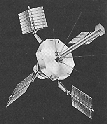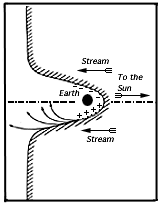|
They realized that the strong field of the Earth would hold off the cloud, carving a cavity in the cloud in which the Earth and its magnetic field would be confined (see drawing above, from their 1931 article). They also speculated that a ring current would then be set up, though they had no clear idea of the way it happened.
The theory of the "Chapman-Ferraro Cavity" proved to be prophetic, except for one important detail: the flow of plasma from the Sun was not confined to isolated clouds, but went on all the time, in the form of the solar wind. Denser and faster clouds, such as arise from coronal mass ejections (see corona), were later identified as the real cause of sudden commencements.
 |
| Explorer 12 |
The magnetopause itself was first observed in 1961 by NASA's Explorer 12. Many satellites have since then studied and probed it--notably, Europe's HEOS 1 and 2 (1975-6) above the poles, as well as NASA's ISEE-3 (1983) and Japan's Geotail (1992-4), extended missions which, during the marked years, probed the distant tail region, up to distances
Further reading:
- Ferraro, Vincent C.A., "The Birth of a Theory" (an account of the beginnings of the Chapman-Ferraro theory), p. 14-18 in Sidney Chapman, Eighty, by S.-I. Akasofu, B. Fogle and B. Haurwitz, U. of Colorado Press, Boulder, 1969.
- Cahill, Lawrence J., Jr., "Early study of the boundary of the geomagnetic field" (an account of the Explorer 12 observations), in Physics of the Magnetopause, B.U.Ö.Sonnerup and P. Song, editors, Amer. Geophys. Union, Washington, D.C. 1995.
Questions from Users:
***
Does our magnetic field stop the atmosphere from getting blown away?
*** Blocking of the Solar Wind by our Moon?
|

